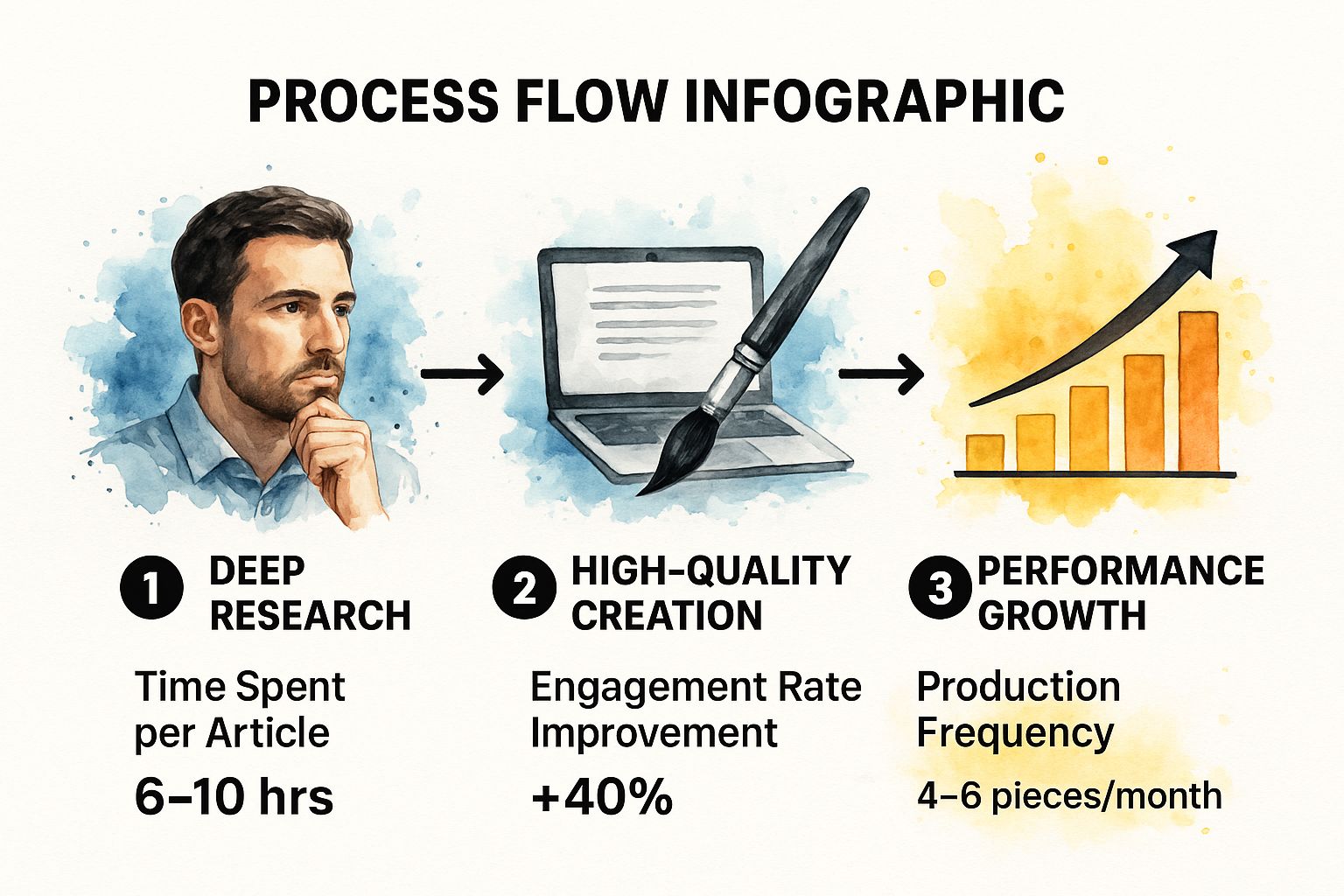In the crowded digital marketplace, simply creating content is not enough. Many businesses invest significant time and resources only to see minimal returns: low traffic, poor engagement, and no real impact on the bottom line. The critical difference between content that flounders and content that converts lies in a strategic, deliberate approach. It’s about moving past generic advice and adopting proven frameworks that consistently deliver measurable results.
This guide cuts through the noise to provide a detailed, actionable blueprint built on 10 essential content marketing best practices. Each one is a critical pillar for building a powerful content engine that attracts, engages, and converts your target audience. Following these principles will help transform your content from a cost center into a reliable growth driver.
Whether you're a startup entrepreneur trying to gain traction or a seasoned marketer looking to refine your strategy, mastering these concepts will redefine your approach. We will cover everything from creating a documented strategy and mapping the customer journey to leveraging data and building thought leadership. This is your roadmap to turning content into your most effective marketing asset.
1. Create a Documented Content Strategy
The difference between successful and unsuccessful content marketing often comes down to one simple factor: documentation. A documented content strategy is a comprehensive, written plan that serves as your North Star. It transforms your efforts from random acts of content into a cohesive, goal-driven machine, making it one of the most crucial content marketing best practices to implement. This foundational document outlines your business objectives, target audience, content pillars, distribution channels, and key performance indicators (KPIs).

Without a written plan, teams lack direction, leading to inconsistent messaging and wasted resources. A documented strategy ensures everyone, from writers to designers, is aligned with the same mission. For example, Salesforce develops highly specific content for different buyer personas, from a small business owner to a B2B sales manager, all guided by their central strategy.
How to Implement This Practice
- Start with Business Goals: Define what you want to achieve. Do you need more leads, better brand awareness, or higher customer retention? Your content goals must directly support these objectives.
- Develop Buyer Personas: Go beyond basic demographics. Use research, surveys, and customer interviews to build detailed personas that capture their pain points, motivations, and media consumption habits.
- Define Your Content Pillars: Establish 3-5 core topics that your brand will own. These pillars should align your audience's interests with your business expertise.
- Map Out Your Operations: Document your content creation workflow, from ideation to publication. To effectively manage your content pipeline and maintain consistency, exploring various free editorial calendar templates can be incredibly beneficial.
- Establish Success Metrics: Define how you will measure success for each goal. This could be organic traffic, conversion rates, or social engagement. Make your strategy a living document by scheduling regular reviews and updates.
2. Focus on Quality Over Quantity
In an era of content shock, prioritizing depth and value over sheer volume has become a cornerstone of effective content marketing. This practice involves shifting resources from churning out daily, low-impact posts to creating fewer, more substantial assets that truly resonate with your audience. Embracing this philosophy is one of the most impactful content marketing best practices because high-quality content builds authority, earns trust, and delivers superior long-term ROI. It's the difference between being a fleeting voice and a go-to resource.
This process flow infographic visualizes how investing more time in research and creation leads directly to enhanced performance.

The data clearly shows that dedicating significant hours to a single piece of content correlates with a substantial increase in engagement, justifying a lower production frequency. For instance, Buffer's highly anticipated "State of Social" reports, built on original research, generate far more industry impact and backlinks than dozens of generic blog posts combined. Similarly, Moz’s Whiteboard Friday videos provide deep, expert-led SEO insights that have cemented their position as industry leaders.
How to Implement This Practice
- Conduct Deep Audience Research: Move beyond surface-level personas. Use surveys, customer interviews, and forum discussions to identify specific, urgent pain points that your content can solve comprehensively.
- Invest in Subject Matter Expertise: Collaborate with genuine experts, whether internal or external, to ensure your content is accurate, authoritative, and offers unique perspectives. Quality writing is essential to translate this expertise effectively.
- Prioritize Original Data: Instead of just curating existing information, create your own. Conduct surveys, analyze proprietary data, or perform original experiments. This makes your content a primary source that others will cite.
- Create Evergreen "Pillar" Content: Focus on producing foundational, long-form guides and resources that will remain relevant and valuable for years. These assets serve as a long-term traffic and lead generation engine.
- Audit and Enhance Existing Content: Regularly identify your top-performing pieces and invest time in updating them with new data, improved visuals, and deeper insights to maintain their value and search rankings.
3. Understand and Map the Customer Journey
Effective content marketing is about delivering the right message to the right person at the right time. To do this, you must understand and map the customer journey, a foundational process that aligns your content with a prospect's evolving needs. This involves creating distinct content for each stage: Awareness, Consideration, Decision, and Advocacy. Following these content marketing best practices ensures you guide users seamlessly from their first interaction to becoming loyal customers, rather than pushing a hard sell too early.

Mapping this journey allows you to provide value at every touchpoint, building trust and authority. For instance, Shopify excels at this by offering "business idea" blogs for the Awareness stage, detailed e-commerce tutorials for Consideration, and platform comparisons for the Decision stage. This strategic progression meets prospects exactly where they are, making the path to conversion feel natural and helpful.
How to Implement This Practice
- Interview Sales and Support Teams: Your customer-facing teams have firsthand knowledge of common questions, objections, and pain points at different buying stages. Use these insights to build an accurate journey map.
- Create Content Clusters for Each Stage: Develop a group of related content for each phase. For Awareness, create blog posts and infographics. For Consideration, produce case studies and webinars. For Decision, offer free trials and demos.
- Use Stage-Appropriate Calls-to-Action (CTAs): Align your CTAs with the user's intent. An Awareness-stage blog post should invite readers to download an ebook, not to "Buy Now." A Decision-stage page, however, should guide users toward a consultation or purchase.
- Develop Nurture Sequences: Use email marketing to create automated workflows that guide prospects from one stage to the next. If someone downloads an Awareness-stage guide, send them follow-up emails with Consideration-stage content.
- Track Performance by Funnel Stage: Analyze your metrics to see how well content at each stage is performing. Are you getting enough top-of-funnel traffic? Are users converting from the consideration to the decision phase? Adjust your strategy based on this data.
4. Optimize Content for Search Engines (SEO)
Creating exceptional content is only half the battle; ensuring your audience can find it is the other. This is where search engine optimization (SEO) becomes essential. Optimizing content for search engines involves strategically structuring and refining your work to rank highly on search engine results pages (SERPs) for relevant queries. This practice bridges the gap between valuable information and the people actively seeking it, making it one of the most powerful content marketing best practices for driving sustainable, organic traffic.
Effective SEO is not about stuffing keywords but about understanding and satisfying search intent. When you create content that comprehensively answers a user's question, search engines like Google reward you with higher visibility. For instance, Backlinko’s in-depth guides consistently rank for highly competitive SEO terms because they are the most authoritative and user-centric resources available, demonstrating a masterful alignment of content value with search intent.
How to Implement This Practice
- Conduct Thorough Keyword Research: Use tools like Ahrefs or Semrush to identify the specific terms and questions your target audience is searching for. Focus on keywords that balance search volume with achievable ranking difficulty.
- Align with Search Intent: Analyze the top-ranking results for your target keyword. Are they blog posts, videos, or product pages? Structure your content to match the format and depth that users expect.
- Prioritize On-Page SEO: Optimize key elements like your title tag, meta description, headers (H1, H2, H3), and image alt text. Weave your primary and related keywords naturally throughout the text.
- Build Authority with Comprehensive Content: Create long-form, pillar-style content that covers a topic exhaustively. This positions your brand as an authority and attracts valuable, high-quality backlinks.
- Monitor and Refresh Performance: SEO is an ongoing process. Regularly track your content's rankings and traffic using tools like Google Analytics and Search Console. Update and republish older posts to keep them fresh and accurate.
5. Maintain Consistent Brand Voice and Messaging
Your brand voice is the distinct personality your brand takes on in all communications. A consistent voice and messaging strategy ensures that whether a customer is reading a blog post, a social media update, or an email, the experience feels familiar and cohesive. This builds trust, fosters brand recognition, and creates an emotional connection, making it one of the most critical content marketing best practices for differentiating your brand from competitors.

Without consistency, your brand can feel disjointed and untrustworthy. A strong, recognizable voice, however, turns your content into a powerful asset. For example, MailChimp has mastered a friendly, helpful, and slightly quirky voice that resonates with its audience of small business owners, making complex marketing topics feel approachable and less intimidating across all its platforms.
How to Implement This Practice
- Define Your Brand Personality: Start by choosing 3-5 core adjectives that describe your brand's character (e.g., authoritative, witty, empathetic, innovative). Use these to guide every piece of content.
- Create Voice and Tone Guidelines: Document your voice in a style guide. Include specific rules on grammar, punctuation, and word choice, along with "do and don't" examples to clarify the intended tone.
- Train Your Content Creators: Ensure everyone who creates content, from internal teams to freelancers, is thoroughly trained on your voice guidelines. Regular workshops can help maintain alignment.
- Audit Your Content Regularly: Periodically review your published content across all channels to check for consistency. This helps identify any deviations and correct them before they become ingrained.
- Gather Audience Feedback: Use surveys or social listening to understand how your audience perceives your brand's voice. This feedback is invaluable for refining your approach and ensuring it resonates effectively.
6. Leverage Data and Analytics for Content Decisions
Relying on intuition alone is a surefire way to limit your content's impact. The most effective marketing programs use data to guide their decisions, transforming content creation from a guessing game into a strategic science. Leveraging data and analytics means systematically tracking, analyzing, and applying insights about audience behavior and content performance. This data-driven approach is a cornerstone of modern content marketing best practices because it allows you to optimize for what truly works, not just what you think will work.
This method ensures your resources are invested in content that demonstrably drives results. For example, Netflix famously uses massive amounts of viewing data, from what scenes users rewatch to when they pause, to inform everything from greenlighting new shows to designing promotional thumbnails. Similarly, BuzzFeed built its empire by analyzing which headlines, formats, and topics generated the most social shares, then replicating those successful patterns.
How to Implement This Practice
- Define Clear KPIs: Start by identifying key performance indicators (KPIs) that directly align with your business goals. These could include conversion rates, time on page, bounce rate, or lead quality. Focus on actionable metrics, not just vanity metrics like page views.
- Set Up Proper Tracking: Implement analytics tools like Google Analytics 4, a CRM, and heatmaps (e.g., Hotjar). Ensure you have proper conversion tracking and attribution models set up to understand which content is driving valuable actions.
- Establish a Reporting Cadence: Create a schedule for reviewing your data, whether weekly, monthly, or quarterly. Develop dashboards that make it easy to spot trends, identify top-performing content, and pinpoint areas for improvement.
- Use Data to Inform, Not Dictate: Data should guide your creative instincts, not replace them. Use analytics to understand what topics resonate and what formats perform best, then let your creative team innovate within those proven frameworks.
- A/B Test Your Content: Continuously test different elements of your content. Experiment with headlines, calls-to-action, imagery, and formats to discover what yields the best results for your specific audience.
7. Repurpose and Maximize Content Value
Creating high-quality content requires significant investment, so why let it have a one-time impact? Repurposing is the art of strategically transforming one content asset into multiple pieces for different channels and formats. This approach extends the lifecycle of your best work, maximizes its reach, and appeals to audiences with varied consumption preferences, making it one of the most efficient content marketing best practices you can adopt. It’s about working smarter, not harder, to get more value from your initial effort.
This method transforms a single pillar piece, like a webinar or in-depth guide, into a comprehensive content ecosystem. For example, marketing powerhouse HubSpot frequently converts a single webinar into a series of blog posts, social media carousels, quote graphics, and even a downloadable PDF checklist. This ensures the core message reaches people whether they prefer watching, reading, or scrolling.
How to Implement This Practice
- Plan for Repurposing Early: During the initial content creation phase, brainstorm potential spin-off ideas. A detailed interview, for instance, can be planned to yield a long-form video, an audio podcast, a summary blog post, and several social media clips.
- Adapt Content for the Platform: Avoid simply copying and pasting. Tailor the tone, format, and message for each channel. A professional insight shared on LinkedIn should be reframed to be more conversational and visual for Instagram. When adapting your content for various social media platforms, specific tools can help streamline the creation of new posts, such as a Reddit post generator.
- Create a Content Atomization Model: Map out how a "pillar" piece of content will be broken down into "micro" content. For example, one research report can become ten data-driven tweets, five infographic snippets, three short-form videos, and one summary email newsletter.
- Update and Refresh Evergreen Content: Identify your high-performing older content and give it a "repurposing refresh." Update statistics, add new insights, and republish it as a new, improved version to regain traffic and relevance.
8. Build and Nurture Community Engagement
Great content marketing isn't a one-way broadcast; it's a two-way conversation. Building and nurturing an engaged community transforms your audience from passive consumers into active brand advocates. This approach focuses on creating spaces and opportunities for genuine interaction, making your audience feel heard, valued, and connected to your brand and each other. This is one of the most powerful content marketing best practices for fostering long-term loyalty and trust.
A thriving community becomes a powerful asset, providing social proof, generating authentic content, and offering invaluable feedback. For example, Sephora’s Beauty Insider Community is a dedicated platform where users share reviews, ask questions, and post tutorials, creating a self-sustaining ecosystem of engagement that strengthens brand loyalty far beyond simple transactions. This direct interaction builds powerful relationships that are difficult for competitors to replicate.
How to Implement This Practice
- Create Dedicated Community Spaces: Establish a forum, a private social media group (like on Facebook or Slack), or a dedicated section on your website where your audience can connect.
- Encourage and Showcase User-Generated Content (UGC): Actively ask your audience to share their experiences. Create branded hashtags and regularly feature customer posts, photos, or testimonials on your official channels.
- Host Interactive Events: Organize live Q&As, Ask Me Anything (AMA) sessions with experts, webinars, or virtual workshops. These events provide direct value and create a sense of shared experience.
- Engage Actively and Authentically: Don't just post and ghost. Respond to comments and messages promptly and thoughtfully. Ask questions in your content to spark discussions and show you are listening.
- Establish Clear Guidelines: To ensure a safe and positive environment, create and enforce community guidelines. Moderate discussions to prevent spam and foster respectful interactions.
9. Develop Thought Leadership and Industry Authority
Thought leadership elevates your content from simply informative to truly influential. It involves positioning your brand and its key people as trusted experts and innovative thinkers in your industry. This is accomplished through high-quality, insightful content that offers original perspectives on trends and challenges, making it a powerful component of any modern content marketing best practices framework. When customers see you as the definitive source of knowledge, they trust your solutions more readily.
This approach transforms your brand from a mere participant into a market leader. For instance, Salesforce CEO Marc Benioff has successfully used his platform to lead conversations on stakeholder capitalism and business equality, tying the brand to forward-thinking principles. This builds authority and a loyal following that extends beyond the product itself. True thought leadership shapes industry dialogue rather than just reacting to it.
How to Implement This Practice
- Identify Your Unique Angle: Focus on topics where your brand has genuine expertise and a unique perspective. Don't just regurgitate existing information; add your original analysis or insights.
- Publish Original Research: Conduct surveys, analyze your internal data, and publish the findings. Releasing proprietary data or a comprehensive industry report immediately positions you as an authority.
- Take a Stand on Key Issues: Don't be afraid to have a strong, well-reasoned opinion on important industry debates. Articulating a clear viewpoint helps you stand out and attract a like-minded audience.
- Leverage Executive Voices: Feature your company's leaders on podcasts, in bylined articles for major publications, and on platforms like LinkedIn. This gives a human face to your expertise.
- Be Consistent Over Time: Authority isn't built overnight. Consistently share valuable insights across your chosen channels to build momentum and reinforce your expert status.
10. Create Educational and Value-First Content
The fastest way to lose an audience is to sell too hard, too soon. A superior approach involves prioritizing content that genuinely helps, educates, or solves problems. This value-first strategy builds trust and establishes your brand as a credible authority, making it a cornerstone among content marketing best practices. By leading with valuable information instead of aggressive sales messaging, you create a positive brand association that nurtures potential customers long before they are ready to buy.
This model transforms your content from a simple advertisement into an indispensable resource. Think of HubSpot Academy, which offers extensive free courses on marketing and sales, subtly demonstrating the power of its platform. Similarly, Moz’s SEO Learning Center provides comprehensive guides that cement its reputation as a search marketing leader, naturally attracting users to its paid tools. This approach turns your expertise into your most powerful marketing asset.
How to Implement This Practice
- Address Real Customer Pain Points: Use customer feedback, keyword research, and sales team insights to identify the most pressing questions and challenges your audience faces. Create content that directly answers these needs.
- Create Comprehensive, Actionable Resources: Develop in-depth guides, tutorials, or webinars that provide clear, step-by-step solutions. Go beyond theory and give your audience tangible takeaways they can implement immediately.
- Offer Free Tools and Templates: Provide value through free resources like calculators, checklists, or templates. This not only helps your audience but also captures leads and showcases your brand's utility.
- Structure for Progressive Learning: Organize your content into logical learning paths or topic clusters. This guides users from foundational knowledge to more advanced concepts, keeping them engaged with your brand for longer.
- Integrate Product Mentions Naturally: While the primary goal is education, you can include subtle mentions of your product where it directly solves a problem discussed in the content. To streamline your creation process and ensure your content meets high editorial standards, utilizing an effective content editor can be highly beneficial.
Content Marketing Best Practices Comparison
| Strategy / Approach | Implementation Complexity 🔄 | Resource Requirements ⚡ | Expected Outcomes 📊 | Ideal Use Cases 💡 | Key Advantages ⭐ |
|---|---|---|---|---|---|
| Create a Documented Content Strategy | Medium to High 🔄 | Medium to High ⚡ | Clear direction, alignment, measurable results 📊 | Teams needing structured content planning | Consistency, focus, better resource allocation ⭐ |
| Focus on Quality Over Quantity | Medium 🔄 | High ⚡ | Higher engagement, SEO, authority 📊 | Brands valuing depth and long-term growth | Builds trust, thought leadership, better SEO ⭐ |
| Understand and Map the Customer Journey | High 🔄 | Medium to High ⚡ | Increased conversions, relevance, targeted promotion 📊 | Complex sales processes or funnels | Better user experience and sales support ⭐ |
| Optimize Content for Search Engines (SEO) | Medium 🔄 | Medium ⚡ | Organic traffic growth, brand visibility 📊 | Content aiming for search-driven traffic | Long-term ROI, high-intent audience targeting ⭐ |
| Maintain Consistent Brand Voice & Messaging | Medium 🔄 | Medium ⚡ | Strong brand recognition and trust 📊 | Brands focused on emotional connection | Differentiation, trust, and marketing effectiveness ⭐ |
| Leverage Data and Analytics for Content Decisions | High 🔄 | Medium to High ⚡ | Data-driven improvements, clear ROI 📊 | Teams with data access and analytics skill | Identifies top content, audience insights ⭐ |
| Repurpose and Maximize Content Value | Medium 🔄 | Medium ⚡ | Extended content lifespan, wider reach 📊 | Content-heavy brands with multi-channel needs | Efficiency, increased ROI, audience diversification ⭐ |
| Build and Nurture Community Engagement | High 🔄 | High ⚡ | Stronger loyalty, brand advocacy 📊 | Brands valuing interaction and feedback | Enhanced relationships, word-of-mouth marketing ⭐ |
| Develop Thought Leadership & Industry Authority | High 🔄 | High ⚡ | Credibility, premium positioning 📊 | Experts and brands aiming for authority | Trust, media opportunities, competitive edge ⭐ |
| Create Educational and Value-First Content | Medium 🔄 | Medium to High ⚡ | Credibility, trust, quality leads 📊 | Brands prioritizing education and support | Builds long-term relationships, SEO benefits ⭐ |
Turn Your Content into a Growth Engine
Navigating the landscape of modern digital marketing requires more than just creating content; it demands a strategic, disciplined approach. The journey from a simple blog post to a powerful growth engine is built on the foundation of the content marketing best practices we've explored. This isn't about checking boxes on a generic to-do list. It's about fundamentally shifting your perspective to see content as a core business asset that builds lasting relationships and drives sustainable growth.
The ten principles detailed in this guide, from creating a documented content strategy to fostering community engagement, are not isolated tactics. They are interconnected pillars that support a robust and effective content operation. A documented strategy provides the blueprint, while a deep understanding of the customer journey ensures your efforts are relevant and timely. Meanwhile, a commitment to quality over quantity, reinforced by data-driven decisions, guarantees your content truly serves its purpose: to educate, inform, and build trust.
From Theory to Actionable Strategy
Mastering these concepts transforms your marketing from a cost center into a predictable revenue driver. When you consistently apply these content marketing best practices, you stop chasing fleeting trends and start building a resilient brand. You move from simply publishing content to strategically developing thought leadership and establishing industry authority. This is how you attract high-quality leads, shorten sales cycles, and build a loyal audience that advocates for your brand. The key is to commit to the process.
To begin turning these insights into tangible results, focus on taking concrete, manageable steps:
- Start with an Audit: Before creating anything new, evaluate your existing content against these principles. Where are the biggest gaps? Identify one or two key areas, such as documenting your strategy or mapping the customer journey, to tackle first.
- Prioritize a Single Initiative: Don't try to overhaul everything at once. Perhaps your most pressing need is to improve your SEO optimization process or to start a formal content repurposing plan. Master one practice, measure its impact, and then expand your efforts.
- Embrace Continuous Improvement: The digital landscape is always evolving. Regularly revisit your strategy, analyze your performance metrics, and solicit feedback from your audience. Treat your content marketing as a living, breathing part of your business that adapts and improves over time.
Ultimately, adopting these content marketing best practices is an investment in your brand's future. It’s the difference between shouting into the void and having meaningful conversations with people who need your solution. By committing to this strategic framework, you empower your business to not just participate in the conversation but to lead it. The path is clear, and the tools are at your disposal. Now is the time to build a content engine that works for you, driving traffic, building authority, and fueling long-term success.
Ready to accelerate your growth and ensure your high-quality content gets the visibility it deserves? rebelgrowth leverages a powerful AI marketing agent and robust backlink networks to amplify your reach and drive targeted traffic. Stop guessing and start growing by visiting rebelgrowth to see how you can automate and scale your content marketing success.
